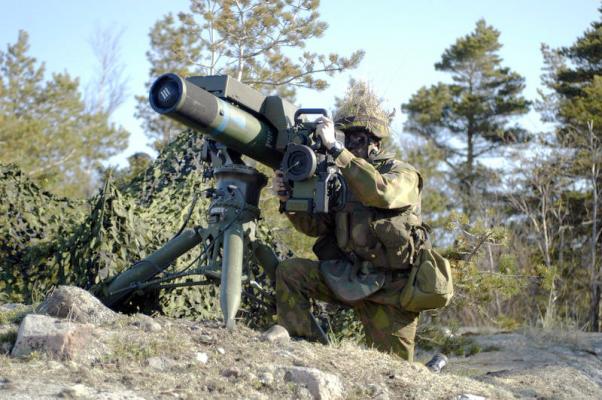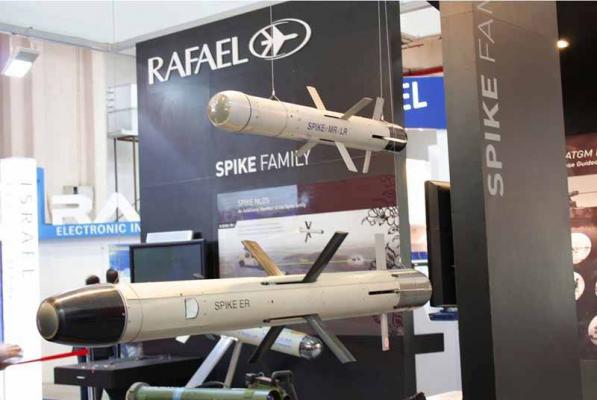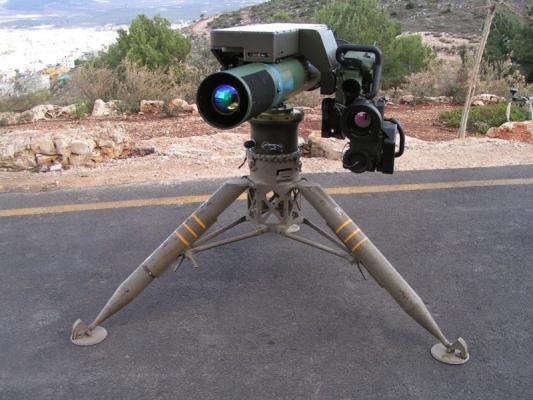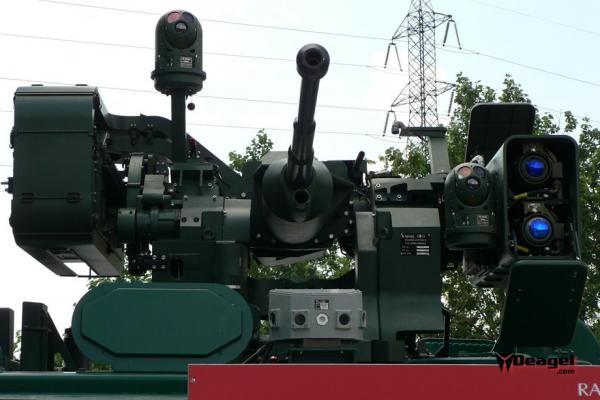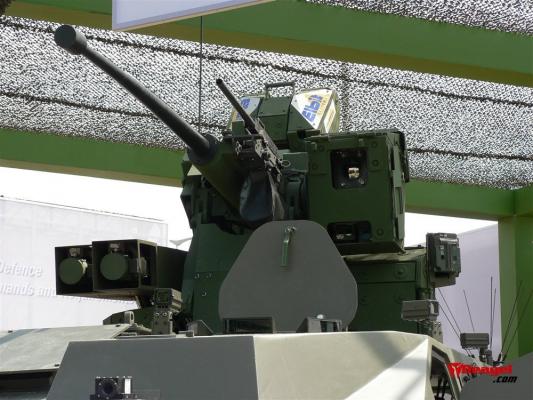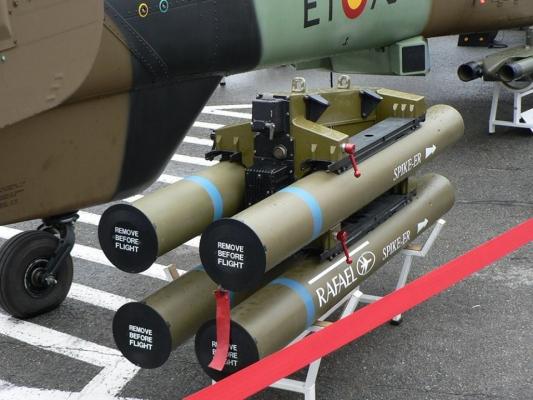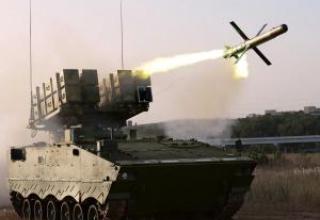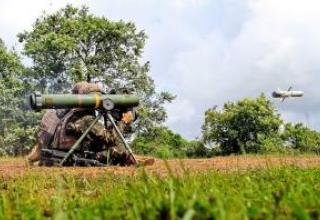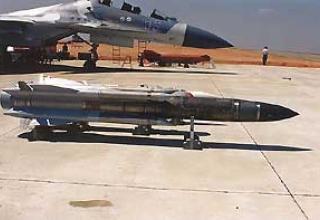The Spike-ER multi-purpose anti-tank missile system is designed to engage modern armored vehicles, including those equipped with dynamic protection, fortifications, enemy manpower, low-speed air and surface targets at any time of day, in difficult weather conditions at ranges up to 8 km.
SPIKE-ER is used for armament of combat helicopters, surface ships, placement on self-propelled chassis of various types, as well as in the wear-wave version.
The SPIKE-ER is part of the Rafael family of attack helicopters, which, in addition to the Spike-ER, includes the Spike-SR lightweight, wearable complex with a range of up to 1500m, Spike-MR with a range of up to 2500m, Spike-LR with a range of up to 4000m, and Spike-NLOS with a range of up to 25km.
In 2004, Rafael, together with German companies Rheinmetall Defence Electronics and Diehl Munitionssysteme (DMS), founded the EuroSpike consortium to produce Spike family complexes for European customers. Licensed production facilities are located in Poland, Spain and Singapore.
Spike-ER complex is in service in the following countries: Israel, Singapore, Czech Republic, Finland, Netherlands, Romania, Croatia, Azerbaijan, Chile, Peru, Portugal, Colombia, Ecuador, Germany, Italy, Poland, Slovenia, Spain, South Korea.
Composition:
The Spike-ER rocket is made according to the normal aerodynamic scheme (see photo) with aerodynamic surfaces opening after the launch.
The thermal imaging head of the homing is located on a double cardan suspension in the forward part of the missile, behind it there is an electronics unit and a tandem cumulative warhead (BC) precharge, behind which there is a solid propellant marching engine. The recessed tandem marching engine nozzles are located between the wings (see photo©Tomasz Szulc).
In the central part of the hull there is a battery and a gyroscope, behind which is the main charge of the BC with automatic triggering and fuse. Folding steering wheels with steering gears and starting engine are placed in the tail of the rocket.
Armor penetrability of tandem cumulative BC is 1000 mm of homogeneous armor. To destroy the fortifications and buildings Spike-ER can be equipped with a high-explosive PBF (Penetration, Blast and Fragmentation) combat unit, which is able to break through the concrete walls, and then explode inside the room, causing maximum damage to the affected object.
The Spike-ER missile has a combined guidance system that includes an uncooled Type IIR thermal/television homing head, an inertial system, and a two-way radio data channel. This makes it possible to implement a wide range of combat applications, including shot-and-forget, target acquisition and redirection after launch, command guidance and implementation of complex flight paths, shooting at an invisible target from a closed position, identification and engagement of the target in the most vulnerable parts.
The disadvantages of the complex include relatively high cost and low flight speed (160-180m/sec).
Bearable variant
The wearable variant of the Spike-ER complex (see photo1, photo2, photo3) includes:
- Spike-ER guided missiles in a transport launch container (TLC);
- launcher in the composition:
- Command Launch Unit (weight 5.1 kg);
- lithium electric battery (weight 1kg);
- thermal imaging sight (weight 4 kg);
- Cooling system cylinder (weight 10.5 kg);
- tripod (weight 10.6 kg);
- trigger body (weight 29 kg); thermal sight (weight 10.5 kg); tripod (weight 10.6 kg); trigger body (weight 29 kg);
- display and documentation unit (see photo) (weight 3 kg);
- maintenance facilities;
- training aids consisting of field and stationary simulators, rocket training models.
Thermal imaging sight (see photo) provides all-day use of the complex and includes a daytime optical sight of tenfold magnification, as well as a thermal imager with an IR detector matrix located in the focal plane of the optical system. The sight has two fields of view, a wide field of view is used for target detection, and a narrow field of view is used for target identification and guidance.
Lifting mechanism of the launcher provides angle of vertical aiming from -10° to +30°, rotary mechanism allows 360° circular aiming.
The Spike-ER tripod is a reinforced tripod that differs from the tripods of other Spike family systems.
The total weight of the complex is 97.2 kg.
Self-propelled chassis placement variants
Spike-ER complex can be placed on self-propelled chassis of different types, including vehicles with cross-country ability (see photo1, photo2). In this case, the modification of the medium is carried out to a minimum extent.
The Samson MkI remote-controlled combat module offered by Rafael has a stabilized main weapon in the center, an optronic kit in an armored container on the right side, and a PTUR container on the left side. The customer can choose from three options: 25 mm ATK M242, 30 mm ATK Mk44 and 30 mm 2A42 of Russian origin. Spike LR/ER and other PTUR models can be used as a missile weapon.
The rifleman has an optronic day/night sight at his disposal, and the commander can make independent observation thanks to the panoramic sight mounted on the mast. Samson MkI can interact with any BIS and is equipped with automatic target tracking system, capable of capturing fast moving targets. The feature of the module is that it can be removed and reduced silhouette of the vehicle when it is not necessary, and raised during combat operations. Samson MkI was purchased by the Czech Army and installed on more than 100 Pandur 8x8 vehicles, some of which were deployed in Afghanistan.
In the summer of 2013 Rafale company completed testing of Samson MkII combat module. With a basic Level 1 protection level according to Stanag, the MkII weighs about 1500 kg, which is 100 kg less than the MkI. The maximum angle of space has increased from +60° to +70°, a useful characteristic when operating in a city or mountains.
Another feature of the MkII module is the fact that the crew can reload the ammo under armor protection; it is placed in a two-row ring magazine inside the tower. For the commander, the tower has a seat, which allows him to observe the situation by sticking his head out through a special hatch. The two missiles are located on the left and are in a row in the new retractable launcher (see photo), which can accept MR, LR and ER versions of the Spike. The MkII can be fitted with the same weapons as the MkI and retains the same search and impact capabilities. The turret protection can be increased to Level 4 with additional armouring.
The new uninhabited mid-calibre UT30 Elbit Systems turret can accept either a 30 mm or 25 mm cannon (air blast ammunition is possible). The cannon is centrally located in the system and is paired with the optronic unit on the left. Two single Spike rifles are mounted on the right side of the weapon.
The gun and the two-axis stabilised sight provide the possibility of firing on the move; the composition of the optronic set is determined according to the customer's requirements, including automatic target tracking. The UT30 turret design allows for modular Level 2-4 protection for weapons and sights; smoke grenades and warning system sensors are available as an option.
Air-based options
PTRK Spike-ER is a part of it:
- Spike-ER guided missiles in transport and launch containers;
- launchers equipped with standard suspension units;
- Top Lite sighting and search system (standard information exchange MIL STD 1553).
The SPIKE-ER system allows the missile to be pointed at its target using a two-way electron-optical image transmission system.
The missiles are placed on the helicopter in two four-charged tubular launchers, which are mounted on standard suspension units on the fuselage. The weight of the launcher - 58kg, weight of the projectile - 187kg. Apart from Spike-ER missiles, Spike-NLOS PTUR can be used on the launcher (see photo).
A set of upgrade systems of the carrier armament, offered by the company Rafael, provides accommodation complex Spike-ER on board helicopters of different types. The kit includes: Rafael TopLite container optoelectronic station, Elbit Systems ANVIS/HUD-24 helmet-based night vision thermal imaging system and helicopter's FIE upgrade kit, which includes a navigation map, multifunctional color display and pilot's monitor.
Spike-ER complex is installed on different types of helicopters, including:
- AgustaWestland AH-129D Mangusta (see фото),
- Eurocopter Tiger HAD(see фото),
- Sikorsky UH-60 Black Hawk (see фото),
- Bell AN-1S Cobra (see фото),
- EC725 Caracal (see фото),
- IAR-330L Socat (see фото).
For use on light helicopters such as Airbus H145, AS550 Fennec, Bell 407, Rafael developed a lightweight dual container Light Helicopter Launcher (see photo1, photo2) for guided Spike missiles. It weighs 27 kg.
It weighs 27 kg and will be launched in 2016. The Israeli Air Force completed a program to upgrade its AH-64AS attack helicopters to the advanced AH-64D Longbow configuration, during which they were able to use Spike-ER anti-tank missiles. A new weapon control system was developed, integrated with the Longbow millimeter-range fire detection and control radar and other systems installed on the carrier. AH-64 can carry 16 Spike-ER missiles.
The Polish Air Force plans to equip 21 Airbus Helicopters H225M helicopters with Spike-ER missiles. According to the plans of the General Staff of the Polish Army, from 2015 to 2018 it is planned to purchase 250 Spike anti-tank systems of various configurations.
The Israeli company IAI/Tamam is offering a project to upgrade the Mi-24, designated Mission-24. It has been used by the Indian Air Force to upgrade 25 helicopters. After the modernization of combat vehicles, along with conventional weapons (PTUR 9K114 "Storm"), were able to use missiles Spike-ER, including at night. The round-the-clock application is provided by the HMSOP (Helicopter Multi-Mission Optronik Payload) multifunctional optoelectronic system developed on the basis of the Tamam MOSP system, which is installed on a number of Israeli UAVs. Primary information sensor of HMSOP complex is used both in daytime and at night, it is interfaced with the helmet display of "Vector" company. The complex has infrared and opto-electronic channels. HMOSP also includes a laser rangefinder and an automatic target tracking system. Night vision goggles or telescopic sight can be integrated into the helmet display. There are special sensors on the helmet that monitor its spatial position, which allows you to orient the HMSOP complex or a four-barrel turret machine gun by simply turning your head. The cabin equipment is made on the principle of "glass cabin" with multifunctional displays. A digital terrain map can be displayed on the display screen.
Elbit Systems offers Mi-24 helicopter upgrade services - its specialists have prepared seven helicopters for Georgia, six - for Macedonia and seven more machines for Sri Lanka.
Shipboard options
Various versions of ship complexes with Spike-ER missiles are used to equip patrol ships and boats.
The Israeli Super Dvora Mk III type surveillance boat is armed with a Rafael Typhoon GS 25 mm tank remotely operated artillery gun, complemented by two Spike-ER missiles (see photo).
At the exhibition of naval weapons in Singapore, IMDEX 2013 introduced a new version of the Typhoon turret unit, designated Typhoon MLS-ER (see photo). The Typhoon MLS-ER turret unit is designed to accommodate, guide and remotely launch four Spike-ER missiles.
The Typhoon MLS-ER turret is part of the Shaldag Mk V high-speed patrol boats of the Azerbaijan Coast Guard (see photo) built by Israel Shipyards.
In March 2017, Rafael Corporation announced successful tests of a version of the Protector multi-purpose robotic marine boat equipped with the Typhoon MLS-ER turret unit. The boat is also equipped with an optical-electronic target designation and fire control system. Concern representatives stated that during the tests all missiles launched from the Protector robotic boat hit targets, including moving ones. During the tests, the wave height was one and a half meters. The developers believe that the boat can be used with waves of up to 4 meters.
The MPAC Mk3 (Multi-Purpose Assault Craft) combat boats of the Philippine Navy are armed with a Mini Typhoon RWS (see photo) turret remote-controlled launcher, which includes a 12.7 mm machine gun and two Spike-ER missiles.
Characteristics:
| Range of fire, m | 400-8000 |
| Dimensions, mm: - length - diameter - wingspan |
1450 150 400 |
| The dimensions of the TIC, mm: - length - diameter |
1670 170 |
| Weight of the rocket in the TPC, kg | 33 |
| Flight speed, m/s: | 160 - 180 |
Testing:
05.09.2008 The US Navy conducted the second test of SM-6 surface-to-air missiles with over-the-horizon guidance. The missile intercepted a BQM-74 air target.
01.09.2012 In the course of the test, SM-6 was used to destroy a cruise missile target and receive designation from the JLENS system.
01.03.2013 Raytheon delivered the first SM-6 to the U.S. Navy, assembled at its new assembly and test facility in Huntsville, Alabama.
14.06.2013 The Republic of Korea has decided to begin equipping its Aegis destroyers with SM-6 anti-aircraft missiles from 2016. The decision was adopted within the South Korean government's programme on the creation of a national air and missile defence system (KAMD).
26.08.2013 The U.S. Navy fired two SM-6 anti-aircraft missiles from the USS CG-52 Chancellorsville (Ticonderoga class), which successfully intercepted two BQM-74 air targets that simulated cruise missiles.
18-20.06.2014 The USS DDG-23 John Paul Jones destroyer launched four SM-6 missiles for training purposes. One of these launches was classified as "the furthest aerial target intercept in naval history".
14.08.2014 Successful launch of SM-6 missile against a low-altitude subsonic target flying over land. The missile, launched at the command of the launch vehicle into the intended target area, independently searched and hit the target. It demonstrated the ability of the missile's ARGSN to successfully counteract interference from the underlying surface.
24.10.2014 Successful reflection of simultaneous attack of low-sonic BQM-74E and supersonic GQM-163A targets simulating anti-ship missiles. Both targets were intercepted at low altitude by SM-6 missiles launched from the USS CG-62 Chancellorsville cruiser. The launch vehicle was behind the radio-horizon, intercepted by the USS DDG 102 Sampson destroyer using SM-6 ARGSN capabilities.
28.07.2015 The US Navy successfully tested a modified version of SM-6 Dual I missile capable of intercepting ballistic targets.
18.01.2016 The SM-6 missile, launched from the USS DDG-23 destroyer John Paul Jones, hit a surface target - the decommissioned USS FFG-57 destroyer Reuben James. The test was a demonstration of the U.S. Navy's "distributed power" concept. According to this concept, it is assumed that as part of a networked ship group, some ships detect targets, others accompany them, and others strike them.
07.03.2016 The destroyer USS DDG-23 John Paul Jones successfully intercepted five targets using SM-6 SSDs, updating the maximum range record for an air target, which was set in 2014.
14.09.2016 The SM-6 missile for the first time intercepted a Zagorizon medium-sonic target using a communication channel with an F-35 fighter. The rocket was launched by the USS Desert Ship (LLS 1) launch complex equipped with the AEGIS Baseline system. The task was the last stage in a series of tests of the Naval Integrated Fire Control Counterair Network (NIFC-CA) designed to provide interaction between U.S. Navy ships and various aircraft (such as F-35 fighter aircraft) in a single integrated network. During the tests, the interceptor missile received continuous target designation from the fighter, which ensured the successful interception of the target outside the detection area of the launch complex radar.
14.12.2016 The U.S. Navy, with support from the U.S. Agency for Defense, conducted the first test of the SM-6 Dual I anti-aircraft missile to intercept a target simulating a medium-range ballistic missile. It was launched off the coast of Hawaii from a USS John Paul Jones destroyer (DDG 53) equipped with the Aegis baseline 9.C1 system. Two missiles were fired at the target.
30.08.2017 Two SM-6 Dual I interceptor missiles were launched from the USS John Paul Jones destroyer (DDG 53) against a target that simulated a medium-range ballistic missile. During the test, the target was detected, captured, escorted, and two interceptor missiles were launched. During the test, the Aegis Baseline 9.1 (BMD 5.0CU) Ballistic Missile Defense (BMD) battle control system was used.
Sources:
- http://www.eurospike.com
- Зарубежные управляемые авиационные средства поражения малого и сверхмалого калибров класса «Воздух–Поверхность»
- Propmech to deliver first MPAC Mk.3 to the Philippine Navy in mid-2017, Israeli Rafael to supply Mini-Typhoon Spike-ER and Spike-NLOS
- Rafael unveils 'hybrid' Spike Typhoon MLS development
- https://indodefense.wordpress.com/category/indonesia/page/53/
- http://www.ownlib.ru/read-38401/no-author/aviatsiia-i-kosmonavtika-1999-09.html
- https://thaimilitaryandasianregion.files.wordpress.com/2017/01/dsc7332_copia.jpg
- Огневое могущество на все случаи жизни. Обзор боевых модулей и башен для машин легкой и средней категорий по массе
- http://www.deagel.com/Weapon-Stations/RCWS_a001398001.aspx
